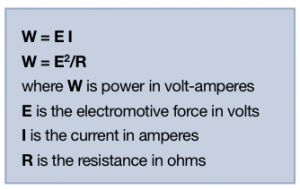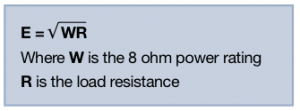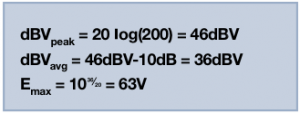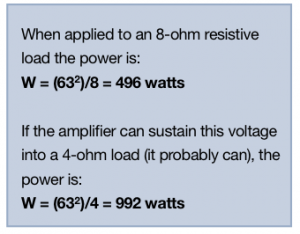Inside Amplifier Power Ratings – Part 2
by Pat Brown
Inside Amplifier Power Ratings – Part 2, Pat Brown addresses this question, “How much power can an audio amplifier produce?”.
How much power can an audio amplifier produce? As you might expect, “it depends.” I will approach this from two angles – in theory and in practice. This article will deal with the theory. Part 3 will show how things play out in the real world.
Importance Of Efficiency
Amplifiers don’t make power. They convert it. Any audio power that comes from your amplifier must in turn come from the utility outlet that it is connected to. This is why the wire gauge of the line cord matters, and why long extension cords can be a problem.
I showed in Part 1 (July 2011 issue) how the power equations calculate the power from the voltage and current, or from the voltage and the load resistance. These simple forms assumes a purely resistive load. That’s good, because that is how amplifiers are usually tested to determine their power rating.
This is the “apparent power” from the source. Apparent power (in volt-amperes) assumes that the voltage and current are in phase, which is only the case for a purely resistive load. The actual power in watts is likely less than the apparent power in volt-amperes given the nature of real-world loads. I’ll assume a resistive load for now and use watts as the unit.
The power equation says that the maximum continuous power from a 120- volt RMS, 15-amp outlet is 1,800 watts. Substitute a 20-amp circuit breaker and the maximum continuous power is 2,400 watts. Note that 20-amp circuits require special outlets and plugs. Since we are talking about theoretical maximums, I will assume a 20-amp circuit.
If the amplifier were 100 percent efficient, it could produce 2,400 watts (34 dBW) of audio power from the 120-volt, 20-amp outlet. The conversion efficiency of modern switch-mode amplifiers (Class D and its variants) can exceed 80 percent, meaning that an amplifier rated at 2 kW continuous is a possibility if it is producing a sine wave.
In effect, the largest amplifiers can produce sine waves that are very close in voltage, current and power to a household electrical circuit in the USA. – an incredible achievement in amplifier evolution. Of course utility power is a 60 Hz sine wave. Music and speech signals are broad band, and will produce considerably less power than a pure sine wave due to the higher crest factor of broadband signals.
Let’s go with this theoretical 2,400- watt amplifier (34 dBW) for now. The wattage puts the best face on the power rating (and looks good on the spec sheet). The dB rating (level) is much more useful to the system designer. But how much power can you really expect from the amplifier? As I showed in Part 1, this “best case” rating provides a reference that must be de-rated by the system designer.
What Do We Really Get?
The amplifier’s job is to accurately reproduce the signal voltage presented to its input. It’s not technically correct to call it a power amplifier, because the output power has nothing to do with the input power – only the input voltage. It has to amplify this voltage while sourcing the current being demanded by the load. As I showed in part 1, this gets tougher as the load impedance drops.
For a constant voltage interface (any modern power amplifier), current is a responder. It is the “result” of the drive voltage and load impedance. Since the load impedance is fixed (unless your loudspeaker overheats), the current (and the resultant power) can only be changed by adjusting the drive voltage to the amplifier. There is no “current knob” on the amplifier!
For this reason, I always do my initial assessment of an amplifier based on its maximum sine wave output voltage. Next I consider the minimum load impedance for which the amplifier can sustain this voltage. The maximum output voltage can be determined from the 8-ohm power rating with the power equation, solved for voltage.
This is easy to verify with an oscilloscope and a (big) dummy load and it is normal to find excellent correlation with the amplifier’s published specifications. No one would falsify a rating that is so easy to verify.
I looked at several of the largest available amplifiers and assessed their voltage output. I won’t compare them here (Part 3 is coming), but the broad conclusion is that an increasing number of them have approximate maximum sine wave voltages in the 130-volt RMS range, which is a peak voltage (multiply by 1.414) close to 200 volts. The term “200 volt rails” is gaining popularity among the amplifier crowd. I’ll assume that such a voltage is possible in this article. I will verify it in Part 3.
A sine wave of 140 volts RMS will produce these wattages into a resistor from an ideal amplifier (one that can source the required current):
You can forget about the 10 kW into 2 ohm sine wave rating for lots of reasons, not the least of which is that you can’t draw that from a typical electrical circuit and the chances are slim that you have a true 2-ohm resistive load. 2,500 watts is within 0.2 dB of the maximum power from the electrical outlet.
That’s “dead on” in amplifier world. Note that all of these rated powers exceed the theoretical 2400 watts that is available from the electrical outlet, especially if the amplifier has multiple channels. Breakers are going to trip! At these wattages, the utility power may be the limiting factor with regard to what amplifier can do.
To assess the music/speech output voltage, I’ll take the rail voltage and convert to dB, and subtract the crest factor of program material. I’ll be generous and assume a crest factor of 10 dB, which is typical of slightly clipped pink noise. I’ll then convert the level back to voltage.
As you can see, the power drops dramatically when you substitute real-world program material for the sine wave. Now, keep in mind that sometimes real-world program material IS a sine wave. A synthesizer can produce very low crest factor signals that can trip circuit breakers and burn-up a sub-woofer connected to the amplifier.
The vast majority of loudspeakers in the marketplace have rated impedances of 4 ohms or higher. The average impedance is higher yet, which is what the amplifier sees if you are playing broadband program material (speech or music). So, to say that we can draw 1 kW from an amplifier is being generous.
It would not be unusual to be able to drive our 2,400-watt amplifier to clipping into a modern line array box using a pink noise signal. Does that mean that the box is “handling” 2,400 watts? No. The high crest factor of the pink noise and the higher real-world average impedance of the loudspeaker means that the power flow is far less than 2,400 watts. It is handling the full voltage swing of the amplifier, but not its full output power.
The high crest factor signal and real-world loudspeaker impedance can allow me to access the full voltage swing of a theoretical amplifier rated at 5 kW/ channel into 4 ohms, so long as the voltage waveform is for broadband program material, NOT a sine wave.
Bottom line? The amplifier will run out of voltage swing before it runs out of power.
Crest Factor & Duty Cycle
If the power from a source cannot be sustained over time, it may be interrupted periodically to avoid damage to the source or the production of excessive heat in the load.
Examples include pumping the brakes on your car when descending a steep hill, or breaking a long weld into shorter segments. A source that cannot run continuously without overheating may be given a duty cycle rating.
Playing a repetitive waveform (like a kick drum) is like pumping the brakes on your car. The power and heat production are reduced. That’s a good thing, since otherwise we’d be tripping circuit breakers and burning voice coils.
In contrast, the largest power ratings on an amplifier spec sheet result from “Burst testing.” This is a method developed for measuring cell phone signals, and it is also used on power amplifiers. A burst test hits the amplifier with a signal that only lasts a few milliseconds. These bursts produce some very high amplitude peaks, but only for a very short period of time.
Looked at another way, burst testing can prevent the circuit breaker from tripping (a good thing) and allow our 2,400 watt amplifier (8 ohm sine wave rating) to drive a 4 ohm load. This (theoretically) doubles the power to nearly 5 kW from a single amplifier channel.
Is this a legitimate power rating for the amplifier?
The moment-by-moment voltage amplitude values of an audio waveform can be very high. Multiplying the instantaneous voltage by the instantaneous current yields the instantaneous power (and some impressive numbers!). Instantaneous power is a means to an end, not the end itself. It must be integrated over time to find the root-mean-square voltage and the average power (a less impressive number!).
We can all pass our finger quickly through the flame of a candle without being burned, but we wouldn’t boast about being able to “handle” the heat of the flame. The short-term transients in the audio signal may not pose a thermal danger to the transducer, so technically they are not over-powering it. They may, however, cause excessive excursion, which is another failure mode of loudspeakers.
While burst signals can have very high amplitudes, they are quite short in duration. The waveform produced by a kick drum is made up of multiple frequencies that are not phase coherent due to the non-linear phase response of the subwoofer. This makes the crest factor high, or looked at another way, the duty cycle low (should drummers have duty cycle ratings?).
Either way, while the voltage amplitude of a kick drum waveform can be very high, the power output from a kick drum is not. A much more punishing waveform would be the continuous sine or square wave output from a synthesizer. This is the only way that you will challenge an amplifier to produce its full rated power, and you may burn up your subwoofer in the process.
Don’t get me wrong. It is a good thing for an amplifier to be able to produce waveforms with very high voltage peaks and instantaneous power. It is not often clear to consumers what this means and under what conditions it is measured (the fine print). All they see is a huge number with “watts” after it and may assume that it is a continuous rating.
There are other issues that complicate the generation of power. Reactive loads (like loudspeakers and transformers) produce a phase shift between the voltage and current. This reflects some of the applied power back at the amplifier and reduces the power delivered to the load. If you’ve ever used a reciprocating saw on a flexible panel, you have experienced mechanical reactance first hand as the saw drives YOU!
So, there are several factors that decimate and nibble away at the theoretical rated power of a multi-kilowatt amplifier.
The good news is that modern multi-kilowatt amplifiers have gotten pretty smart at being able to allow their massive instantaneous power to be utilized without tripping circuit breakers and burning up loads. I’ll revisit this in Part 3.
Need For Conversations
To summarize, it is theoretically possible for a highly efficient audio power amplifier to produce continuous sine wave power in the 2 kW range. For it to actually have to do this is unlikely, given the nature of music and speech signals and the real-world impedances of loudspeakers.
Rating the amplifier based on a very low load impedance, tone burst signal and in linear units (“watts”) is definitely putting the best face on it. Just remember that the “KiloBlaster 10000” gets it rating based on the summed power from multiple channels under these “non typical” conditions.
Since no standard exists for “burst testing” amplifiers, you can bet that it is done differently by every manufacturer. This doesn’t make the numbers meaningless, but you won’t be able to use them to compare different makes and models. You’ll have to compare them the old-fashioned way – listening tests using a massive subwoofer (be sure to warn the neighbors).
In reality, the “KiloBlaster 10000” amplifier from one manufacturer may produce the essentially the same performance as the “SpeakerWelder 12000” from another, and the “ConeMelt 6000” from yet another. Their rated outputs are within 3 dB of each other, and the difference may not be audible under real-world conditions. They may actually measure about the same if tested in the same manner.
Our industry needs to have some serious conversations about power and power ratings for such numbers to be useful for comparison shopping. For now, give me continuous sine wave ratings that I can use to design sound systems. I’ll derate the sine wave ratings based on how I intend to use the amplifier. The reputable manufacturers do this already, but you’ll probably have to read the spec sheet, not the sales brochure, to find them.
Why does any of this matter? We need to keep it real. Idealized rating methods generate misunderstanding and unrealistic expectations among audio practitioners. The consultant who won’t specify an amplifier “under 2 kW” or a loudspeaker with a maximum SPL rating “less than 140 dB” is missing the boat and likely passing over some very good products. The burden is on the audio professional to decipher the power rating into what they can expect when the amplifier is in their customer’s rack, not on the test bench.
In Part 3 I will lay aside the theories and the musings and test some commercially available units under real-world conditions. Someone please warn the neighbors. pb





